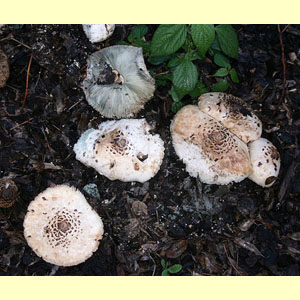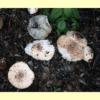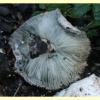


_AM_04_sml.jpg)
Mature spores of Chlorophyllum molybdites do not stain heavily in Congo Red, in contrast to those of C. brunneum [see Bougher (1999), where C. brunneum is referred to as Macrolepiota rachodes].
Bougher, N.L. (1999), The poisonous green-gilled fungus Chlorophyllum molybdites in south Western Australia, Australas. Mycol. 18: 60–62. [Description and Illustration of C. molybdites]
Bougher, N.L. (2009a), Fungi of the Perth region and beyond: a self-managed field book, Western Australian Naturalists' Club (Inc.), Perth. [Description and Illustration of C. molybdites]
Grgurinovic, C.A. (1997a), Larger Fungi of South Australia. The Botanic Gardens of Adelaide and State Herbarium and The Flora and Fauna of South Australia Handbooks Committee, Adelaide. [Description and Microcharacters of C. molybdites]
Imazeki, R., Otani, Y. & Hongo, T. (1988), Fungi of Japan. Yama-Kei Publishers, Tokyo. [Illustration of C. molybdites]
Pegler, D.N. (1977), A preliminary agaric flora of East Africa, Kew Bull., Addit. Ser. 6: 1–615. [Description, B&W Illustration and Microcharacters of C. molybdites]
Reid, D.A. & Eicker, A. (1991a), A comprehensive account of Chlorophyllum molybdites, Bot. Bull. Acad. Sin. 32: 317–333. [Description, B&W Illustration and Microcharacters of C. molybdites]
Southcott, R.V. (1974), Notes on some poisonings and other clinical effects following ingestion of Australian fungi, S. Austral. Clinics 6: 441–478. [Illustration of C. molybdites and discussion of poisoning symptoms]
Vellinga, E.C. (2003a), Chlorophyllum and Macrolepiota (Agaricaceae) in Australia, Austral. Syst. Bot. 16: 361–370. [brief Description of C. molybdites]
Young, T. (1989b), Poisonings by Chlorophyllum molybdites in Australia, Mycologist 3: 11–12. [brief Description and Illustration of C. molybdites and discussion of poisoning symptoms]
Young, A.M. (2005b), A Field Guide to the Fungi of Australia. University of New South Wales Press, Sydney. [Description and B&W Illustration of C. molybdites]
